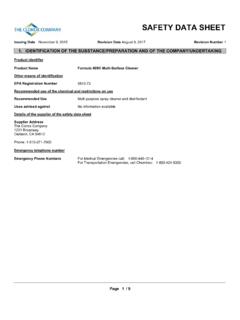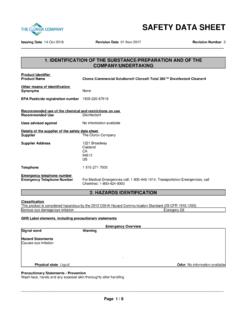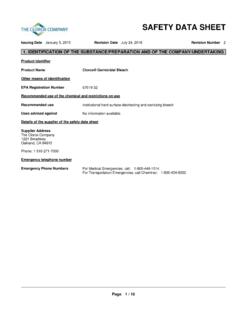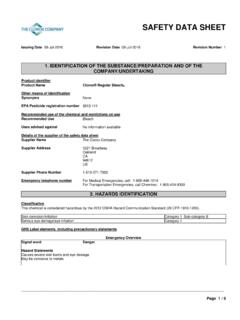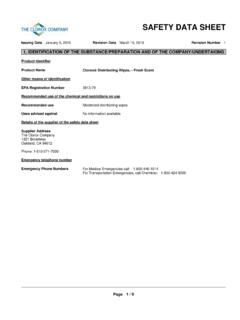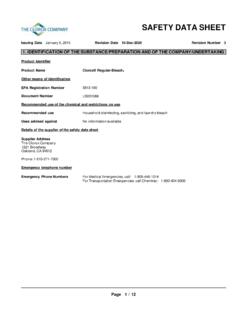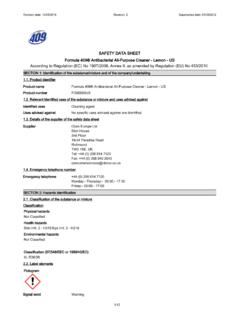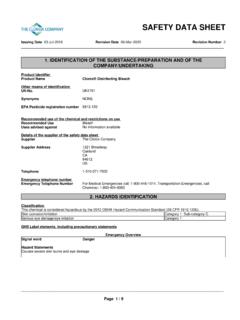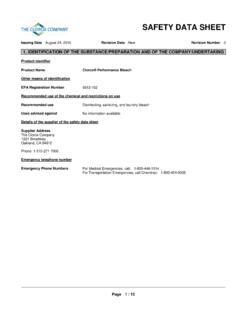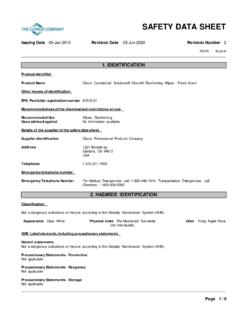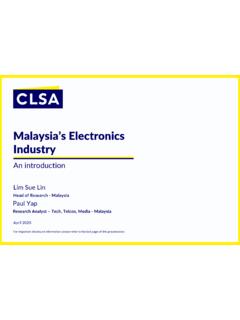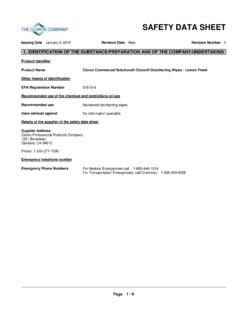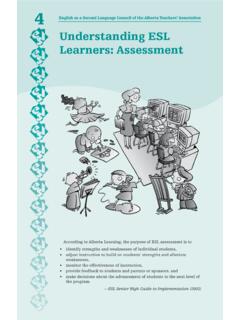Transcription of SAFETY DATA SHEET - Clorox
1 SAFETY DATA SHEET Issuing Date January 5, 2015 Revision Date June 12, 2015 Revision Number 1 Page 1 / 10 1. IDENTIFICATION OF THE SUBSTANCE/PREPARATION AND OF THE COMPANY/UNDERTAKING Product identifier Product Name Clorox Regular-Bleach1 Other means of identification EPA registration Number 5813-100 Recommended use of the chemical and restrictions on use Recommended use Household disinfecting, sanitizing, and laundry bleach Uses advised against No information available Details of the supplier of the SAFETY data SHEET supplier Address The Clorox Company 1221 Broadway Oakland, CA 94612 Phone.
2 1-510-271-7000 Emergency telephone number Emergency Phone Numbers For Medical Emergencies, call: 1-800-446-1014 For Transportation Emergencies, call Chemtrec: 1-800-424-9300 Clorox Regular-Bleach1 Revision Date June 12, 2015 Page 2 / 10 2. HAZARDS IDENTIFICATION Classification This chemical is considered hazardous by the 2012 OSHA Hazard Communication Standard (29 CFR ). Skin corrosion/irritation Category 1 Serious eye damage/eye irritation Category 1 GHS Label elements.
3 Including precautionary statements Emergency Overview Signal word Danger Hazard Statements Causes severe skin burns and eye damage Causes serious eye damage Appearance Clear, pale yellow Physical State Thinliquid Odor Bleach Precautionary Statements - Prevention Wash face, hands and any exposed skin thoroughly after handling. Wear protective gloves, protective clothing, face protection, and eye protection such as SAFETY glasses. Precautionary Statements - Response Immediately call a poison center or doctor.
4 If swallowed: Rinse mouth. Do NOT induce vomiting. If on skin (or hair): Take off immediately all contaminated clothing. Rinse skin with water. Wash contaminated clothing before reuse. If inhaled: Remove person to fresh air and keep comfortable for breathing. Specific treatment (see supplemental first aid instructions on this label). If in eyes: Rinse cautiously with water for several minutes. Remove contact lenses, if present and easy to do. Continue rinsing. Precautionary Statements - Storage Store locked up.
5 Precautionary Statements - Disposal Dispose of contents in accordance with all applicable federal, state, and local regulations. Hazards not otherwise classified (HNOC) Although not expected, heart conditions or chronic respiratory problems such as asthma, chronic bronchitis, or obstructive lung disease may be aggravated by exposure to high concentrations of vapor or mist. Product contains a strong oxidizer. Always flush drains before and after use. Clorox Regular-Bleach1 Revision Date June 12, 2015 Page 3 / 10 Unknown Toxicity Not applicable.
6 Other information Very toxic to aquatic life with long lasting effects. Interactions with Other Chemicals Reacts with other household chemicals such as toilet bowl cleaners, rust removers, acids, or products containing ammonia to produce hazardous irritating gases, such as chlorine and other chlorinated compounds. 3. COMPOSITION/INFORMATION ON INGREDIENTS Chemical Name CAS-No Weight % Trade Secret Sodium hypochlorite 7681-52-9 5 - 10 * * The exact percentage (concentration) of composition has been withheld as a trade secret.
7 4. FIRST AID MEASURES First aid measures General Advice Call a poison control center or doctor immediately for treatment advice. Show this SAFETY data SHEET to the doctor in attendance. Eye Contact Hold eye open and rinse slowly and gently with water for 15 - 20 minutes. Remove contact lenses, if present, after the first 5 minutes, then continue rinsing eye. Call a poison control center or doctor for treatment advice. Skin Contact Take off contaminated clothing. Rinse skin immediately with plenty of water for 15-20 minutes.
8 Call a poison control center or doctor for treatment advice. Inhalation Move to fresh air. If breathing is affected, call a doctor. Ingestion Have person sip a glassful of water if able to swallow. Do not induce vomiting unless told todo so by a poison control center or doctor. Do not give anything by mouth to an unconscious person. Call a poison control center or doctor immediately for treatment advice. Protection of First-aiders Avoid contact with skin, eyes, and clothing. Use personal protective equipment as personal protective clothing (see section 8).
9 Most important symptoms and effects, both acute and delayed Most Important Symptoms and Effects Burning of eyes and skin. Indication of any immediate medical attention and special treatment needed Notes to Physician Treat symptomatically. Probable mucosal damage may contraindicate the use of gastric lavage. Clorox Regular-Bleach1 Revision Date June 12, 2015 Page 4 / 10 5. FIRE-FIGHTING MEASURES Suitable Extinguishing Media Use extinguishing measures that are appropriate to local circumstances and the surrounding environment.
10 Unsuitable Extinguishing Media CAUTION: Use of water spray when fighting fire may be inefficient. Specific Hazards Arising from the Chemical This product causes burns to eyes, skin, and mucous membranes. Thermal decomposition can release sodium chlorate and irritating gases and vapors. Explosion Data Sensitivity to Mechanical Impact None. Sensitivity to Static Discharge None. Protective equipment and precautions for firefightersAs in any fire, wear self-contained breathing apparatus pressure-demand, MSHA/NIOSH (approved or equivalent) and full protectivegear.
